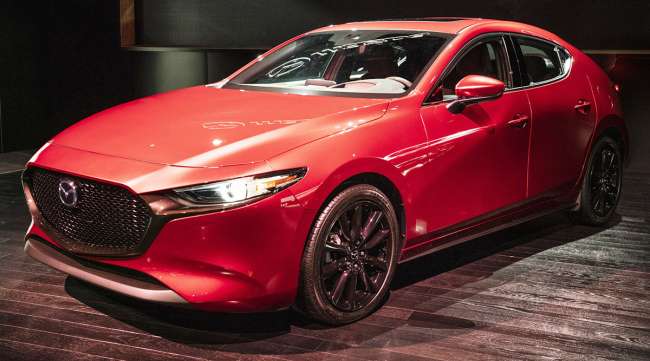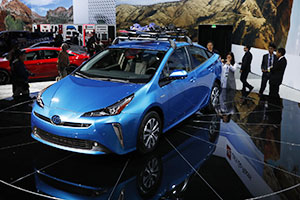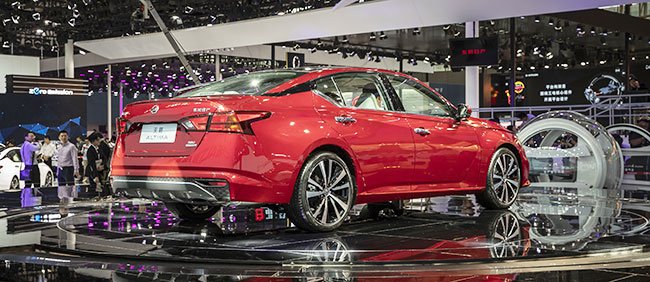Automakers Take Page From SUV Playbook to Ramp Up Sedans

All-wheel-drive sedans used to be a niche market limited to park rangers and uptight snow-belt drivers. These days, they’re becoming a more popular choice for decidedly mainstream models.
The latest entrants to the all-wheel stable include the Mazda6, Nissan Altima and Toyota Prius. As sales of crossovers, SUVs and pickups have grown, automakers are equipping more of their sedans with all-wheel drive to hang on to buyers wanting more SUV-like features.
All-wheel or 4-wheel drive is standard on most SUVs and trucks, helping to boost its availability to a record 63.4% of new vehicles sold last year, up from 56.4% a decade ago, according to data from Edmunds. Automakers are betting that by passing these powertrain variants on to passenger cars, they’ll be able to prop up their sagging sales.
“The transition to SUVs has primed American auto buyers for additional capabilities,” said Jeremy Acevedo, Edmunds’ manager of industry analysis. “The recent increase in cars offering AWD is an attempt to level the playing field between cars and SUVs.”
Nissan Motor Co. began offering all-wheel drive on its latest Altima sedan in the U.S. market in November. Since then, the company says more than 20% of buyers in the United States have opted for the $1,350 package, and close to half of all Altima sales in wintry markets such as the Northeast have all-wheel drive.

A Toyota sedan on display at the Los Ageles Auto Show (Patrick T. Fallon/Bloomberg News)
One of those buyers is Josh Bothell, a 34-year-old retail store supervisor, who recently purchased an Altima from a Nissan dealership in Old Saybrook, Conn. Bothell had owned a 2005 model, then traded that in for a 2013 Subaru Impreza. He said he wouldn’t have gone back to the Altima without the all-wheel drive option.
“I’m really glad Nissan made the Altima AWD,” he said. “I just feel like SUVs are really too big, and I wanted something smaller and compact.”
For decades, all-wheel or 4-wheel drivetrains were relegated to truly off-road vehicles or regional markets with heavy snow with the greatest need for traction on slippery and rough surfaces. Not only were they considered unnecessary for most cars, but powering all four wheels increased cost, weight, mechanical complexity and fuel use. That limited their appeal to hardcore enthusiasts.
But years of lower gasoline prices have made American car buyers less sensitive to slight fuel-economy differentials. And automakers have tweaked their all-wheel-drive systems to improve efficiency. Subaru Corp.’s Crosstrek crossover boasts a respectable combined city and highway rating of 29 mpg. Toyota Motor Corp.’s Prius equipped with its AWD-e system boasts a stellar 50 mpg combined rating.

A Mazda on display at the Shanghai Auto Show (Qilai Shen/Bloomberg News)
“There is no fuel-economy penalty,” said Tom Doll, CEO of Subaru’s U.S. sales unit. “Our all-wheel drive is just as fuel efficient — or more — as others’ front- or rear-wheel drive.”
The Japanese brand is one of the pioneers in bringing all-wheel-drive vehicles to the masses.
“We’re the original all-wheel-drive company,” Doll said.
A handful of mass-market sedans have offered optional AWD, such as Fiat Chrysler Automobiles NV’s Dodge Charger and Ford Motor Co.’s soon-to-be-discontinued Fusion. Luxury cars, including BMW AG and Volkswagen AG’s Audi sedans, also offer it, as do Acura, Infiniti and Lexus sedan models made by Honda Motor Co., Nissan and Toyota, respectively. But the latest wave represents an effort to democratize the technology.
Fiat Chrysler may add all-wheel drive to its Pacifica minivan in a bid to boost sales, trade publication Automotive News reported in March. A spokeswoman said the company hasn’t made any announcements.
Mazda Motor Corp. made all-wheel drive available on its latest Mazda3 compact and plans to offer it on the upcoming makeover of its midsize Mazda6 sedan. Masahiro Moro, chairman of Mazda’s North American operations, expects as many as 40% of Mazda6 buyers to choose the option.
“All-wheel drive gives more of a sense of safety for customers,” Moro said, “and they see it as something like a premium feature.”




